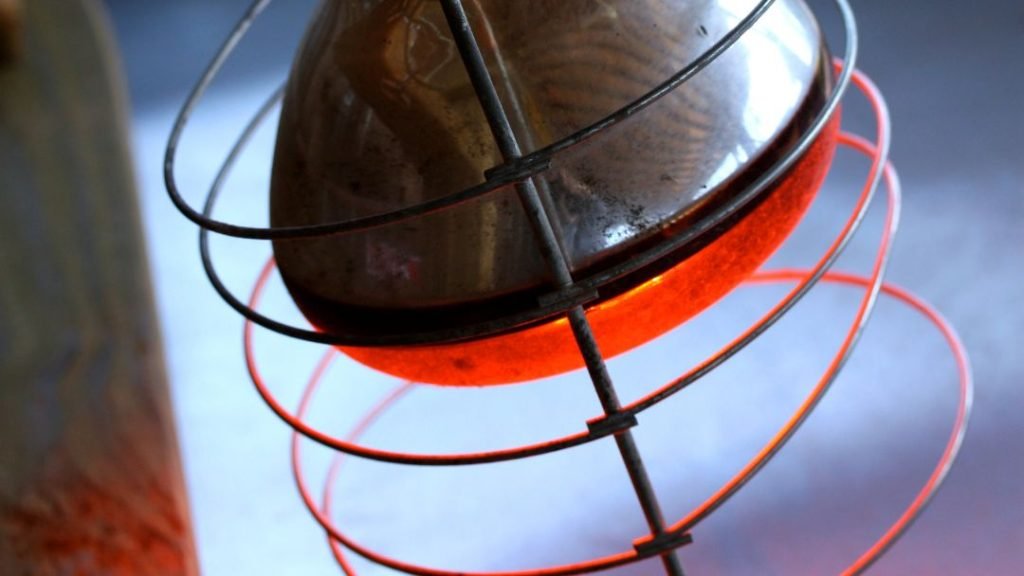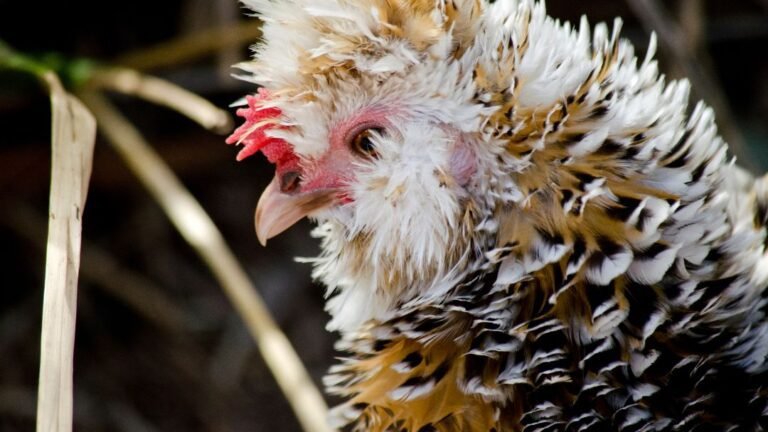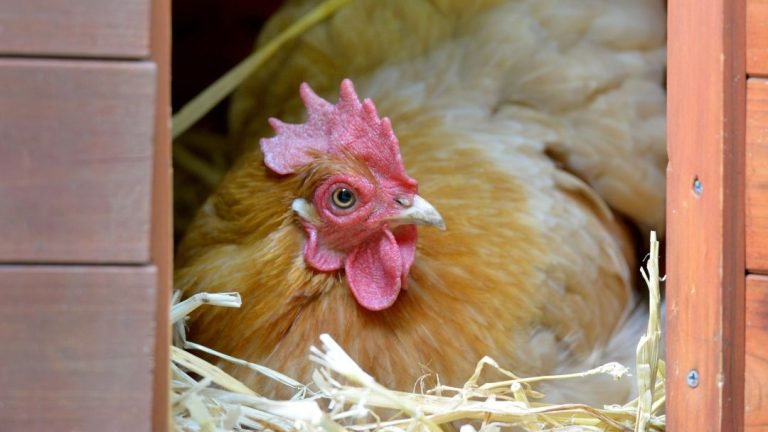Chickens have an impressive ability to survive in cold temperatures. They can live easily at ten degrees Fahrenheit or less temperature. However, when it is extremely cold like the weather is freezing, you need to warm them up. Many chicken keepers use heat lamps.
When to put the heat lamp in the chicken coop? Chickens don’t need heat lamps under normal conditions. But it is better to place one or two hot lights during the freezing weather for sick flocks, young chicks, and brooding periods.
When To Put Heat Lamp In Chicken Coop?
Chicken keepers don’t need to use heat lamps in the chicken coop under normal temperature conditions.
But heat lamps are necessary to use in some highly demanding conditions.
The following are common situations where chicken owners can use heat lamps inside the chicken coop.

01. Freezing weather
Some living locations have a constantly less than zero degrees Celsius temperature during winter.
You need to keep your flocks warm enough during the freezing weather.
However, you must first consider what type of chicken breeds you have.
Cold-hardy breeds can easily survive from 15ºC (5ºF) to -20ºC (-4ºF).
But they will likely face problems if the temperature drops below -25ºC (-13ºF) inside your chicken coop consistently.
If you are raising heat-tolerant chickens, ensuring a warm environment is necessary.
Their cold endurance capability is not as high as cold-hardy chickens.
If your chooks have raspiness or sneezing, coughing, or stretching out their necks, they will likely have cold diseases.
02. Sickly Chickens
Do your chickens have any illnesses? If so, they need special care, especially during the winter months.
You want to ensure your feathered friends a warm, protected, and comfortable environment.
Otherwise, they will become sick if you neglect them.
Set up a heat lamp near the sick flocks to help conserve energy and heat from the light.
Make sure the temperature is not too hot for them. Avoid setting up a high temperature initially.
Choose a lower option initially and increase it gradually if sick chickens are still feeling cold.
If the heat lamp has no customizing option, increase the distance from the ill chooks to avoid overheating them.
03. Young Chicks
Young chicks can’t regulate their metabolic processes.
They have to rely on the external environment to maintain optimal body temperature.
The ideal temperature for the first week of baby chicks is 32 to 35°C (90 to 95°F).
But it can be as low as 28°C (82°F) if the edge of the heat lamp is located within 2m (6′) away.
The following table shows the ideal temperature for different ages of young chicks.
| Age of Chick | Ideal Temperature |
|---|---|
| 0-7 days | 95-100°F (35-38°C) |
| 1-2 weeks | 90-95°F (32-35°C) |
| 3-4 weeks | 85-90°F (29-32°C) |
| 5-6 weeks | 80-85°F (27-29°C) |
| 7-8 weeks | 75-80°F (24-27°C) |
The ideal temperature can be more or less depending on the ambient temperature and humidity in the environment.
04. Brooding Period
Hens need heat during the brooding period to keep their eggs warm and ensure the successful development of their embryos.
When a hen is brooding, she sits on her eggs to keep them at a consistent temperature, typically between 99-102F (37-39C).
This temperature is necessary for the eggs to develop properly and for the embryos to grow and hatch successfully.
The heat also helps stimulate embryo development and maintain its metabolic processes.
Without adequate heat, the embryos may not develop properly, leading to poor hatching rates or even death.
The heat also helps create a humid environment around the eggs, which is also important for proper embryo development.
This humidity helps to prevent the eggs from drying out, which can cause the embryos to become dehydrated and die.
Should I Heat My Chicken Coop In The Winter?
Haven’t you considered providing your flock with heat lamps or other heat sources when you feel cold during the winter?
This is a common practice among most chicken keepers. But we forget that our feathered friends don’t feel as cold as we do during the extreme cold seasons.
Whether it is cold-hardy or heat-tolerated chickens, they can survive easily, even in close to minus or below minus degree temperatures.
But you must be wondering why chickens don’t need a heat lamp when you feel cold, right?
There are two reasons behind it. Firstly, flocks have thicker feathers on top of their body. They keep them from external weather conditions heavily.
Secondly, chooks can naturally regulate their body temperature through their hypothalamus.
Due to the absence of sweat glands, they don’t lose heat through transpiration. It allows them to retain heat for a long time and keep themselves warm.
Why Can Heat Lamps Be A Problem?
It is not always best to use heat lamps.
Chicken keepers may experience various problems from using heat lamps.
The following are common problems chicken owners are likely to face.
01. Fire Hazard
Heat lamps are likely to catch fire as they have infrared radiation.
The fire hazard chances are higher if there is any design fault.
Many chicken keepers buy inferior-quality heat lamps to save a few bucks.
Unfortunately, they pay a heavy price for this mistake.
If you mistakenly keep them near bedding material or any other flammable object, they are likely to cause fire hazards.
The problem may occur if the heat lamps remain unattended for several days.
02. Overheating
Don’t you check and monitor your chicken heat lamp regularly?
When this electrical device continuously runs for several days, it will cause overheating.
Chickens may struggle to regulate their body temperature due to excessive heat.
Reducing the heat when the chicken coop becomes hot enough is necessary.
Otherwise, flocks may have dehydration, heat stress, and even death from intolerable heating conditions.
03. Uneven Heating
Heat lamps often cause uneven heat distribution.
Some spots inside the coop might be too hot, and some are not getting enough heat.
It can cause serious problems for your feathered friends.
This problem mainly occurs from the inappropriate placement of the heat lamp.
Chicken owners often struggle to set the light in the right spot.
Some chooks may stay too close to the heat lamp, and others remain too far away.
04. Higher Cost
Operating several heat lamps daily for hours will lead to much electricity consumption.
However, the total cost will vary by the wattage of the lamp and the electricity rate.
For example, if your heat lamp is rated at 250 watts, and your electricity rate is $0.15 per kilowatt-hour (kWh), then the cost per hour of operation can be calculated as follows:
250 watts ÷ 1000 = 0.25 kWh
0.25 kWh x $0.15/kWh = $0.0375 per hour.
The following table shows the approximate daily, weekly, and monthly heat lamp costs.
| Using Pattern | Calculation | Total Cost |
|---|---|---|
| Daily use | (250 ÷ 1000) x 4 x 0.15 | $0.15 per day |
| Weekly use | (250 ÷ 1000) x 28 x 0.15 | $1.05 per week |
| Monthly use | (250 ÷ 1000) x 120 x 0.15 | $4.50 per month |
How To Use Heat Lamps In Chicken Coop?
Heat lamps are commonly used for keeping chickens warm and comfortable in cold weather.
Here are the general steps to use a heat lamp for chickens:
Step 01: Choosing The Right Heat Lamp
The first job is selecting a heat lamp appropriate for the size of your chicken coop and the number of chickens you have.
A 250-watt heat lamp is usually sufficient for a small to medium-sized coop, but larger coops may require more than one lamp.
Step 02: Installing The Heat Lamp
Hang the heat lamp from the ceiling of the coop using a secure hook or chain
Ensure it is at least 18 inches above the bedding and out of reach of the chickens.
Step 03: Positioning The Heat Lamp
Place the heat lamp in the corner of the coop.
It will allow chickens to stay away from the heat if they become too warm.
Step 04: Turning On The Heat Lamp
Switch on the heat lamp and adjust the height or distance from the bedding to achieve the desired temperature.
You can use a thermometer to monitor the temperature inside the coop.
Step 05: Providing Adequate Ventilation
Ensure enough ventilation in the coop to prevent moisture buildup and maintain good air quality.
It will help you to avoid breathing, vigorous flapping, and panting that often happen from excessive heat.
Step 06: Monitoring The Chickens
Observe the behavior of the chickens to ensure they are comfortable and not too hot or too cold.
Adjust the height or distance of the heat lamp as necessary.
Step 07: Cautiously Using The Lamp
Always use caution when using a heat lamp. It can be a fire hazard if not used properly.
Avoid using flammable bedding materials, and never leave the heat lamp unattended.
How To Take Care of Chickens During Winter?
Flocks need a little extra attention during the winter season.
Here are some pro tips to take care of your feathered friends.
01. Ensure Proper Insulation
Are your chicken coop walls adequate insulation?
They come in handy for both summer and winter seasons.
A well-insulated chicken coop can keep birds safe from extreme weather conditions.
It also keeps humidity levels at optimum and protects them from frostbite, drafts, moisture, etc.
But what insulating materials work best for chooks?
To ensure decent insulation, you can use plywood, insulated panels, structural insulated panels, and recycled plastic boards.
02. Serve More Food In Winter
Do you know why chickens eat more during cold weather?
They require extra calories to keep themselves warm during extreme weather.
Make sure to food diet contains a good amount of extra protection.
Expert chicken keepers generally suggest feeding higher protein, especially from November to March.
You can feed them oatmeal, dark, leafy greens, split pea soup, scratch grains, etc.
But how much extra amount should you serve? It should be 1.5 times more than the regular times.
This will help them regulate their body temperatures effortlessly.
03. Provide A Lot Of Fresh Water
What type of waterer do you use for your chickens? Is it prone to freeze?
If so, you want to serve a lot of fresh water to your feathered friends several times daily.
Remember, chickens eat more during winter to regulate their body temperature.
Properly digesting this food requires drinking a good amount of fresh water.
04. Keep The Coop Dry And Clean
Make sure to perform daily, weekly, and monthly cleaning regularly.
Avoid the buildup of any dirt and chicken droppings. Otherwise, it will affect the chickens’ health.
They may have different health problems, such as frostbite, respiratory issues, etc.
Don’t forget to change the bedding regularly.
You should not give any scope to developing a moisture-based environment from the chicken droppings.
05. Monitor Chickens’ Health
Regularly check your chickens for signs of health problems, such as frostbite or respiratory issues.
If you notice any issues, consult a veterinarian or experienced chicken owner for advice.
Wrapping UP
Are you still wondering when to put a heat lamp in the chicken coop? Using this type of hot light inside the flock house is not mandatory.
Most of the time, birds don’t need it. Besides, installing heat lumps may result in some problems as they are a little risky.
But in some cases, heat lamps can be beneficial if you are a little cautious. Adjust the heat properly to protect your feathered friends from overheating.




